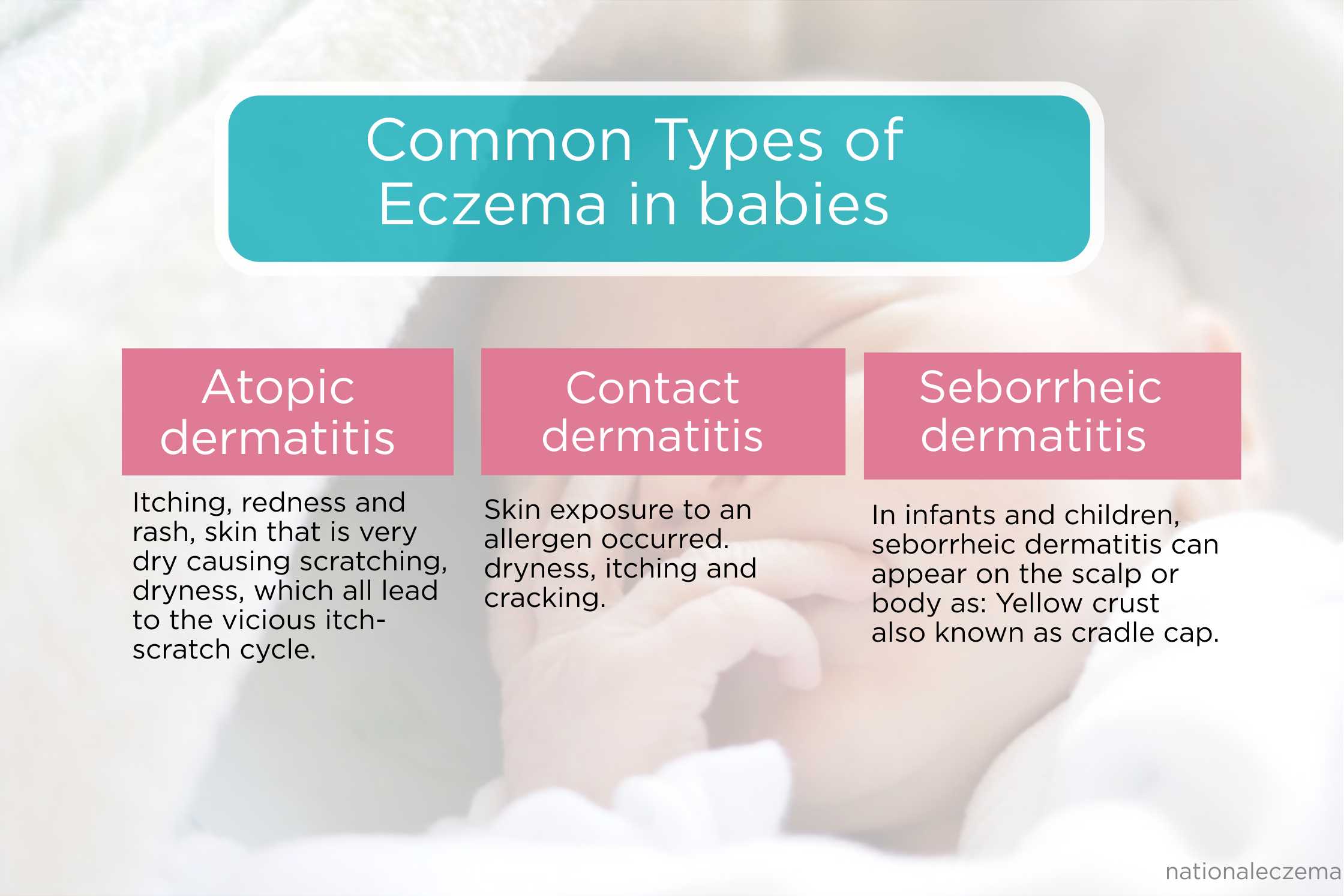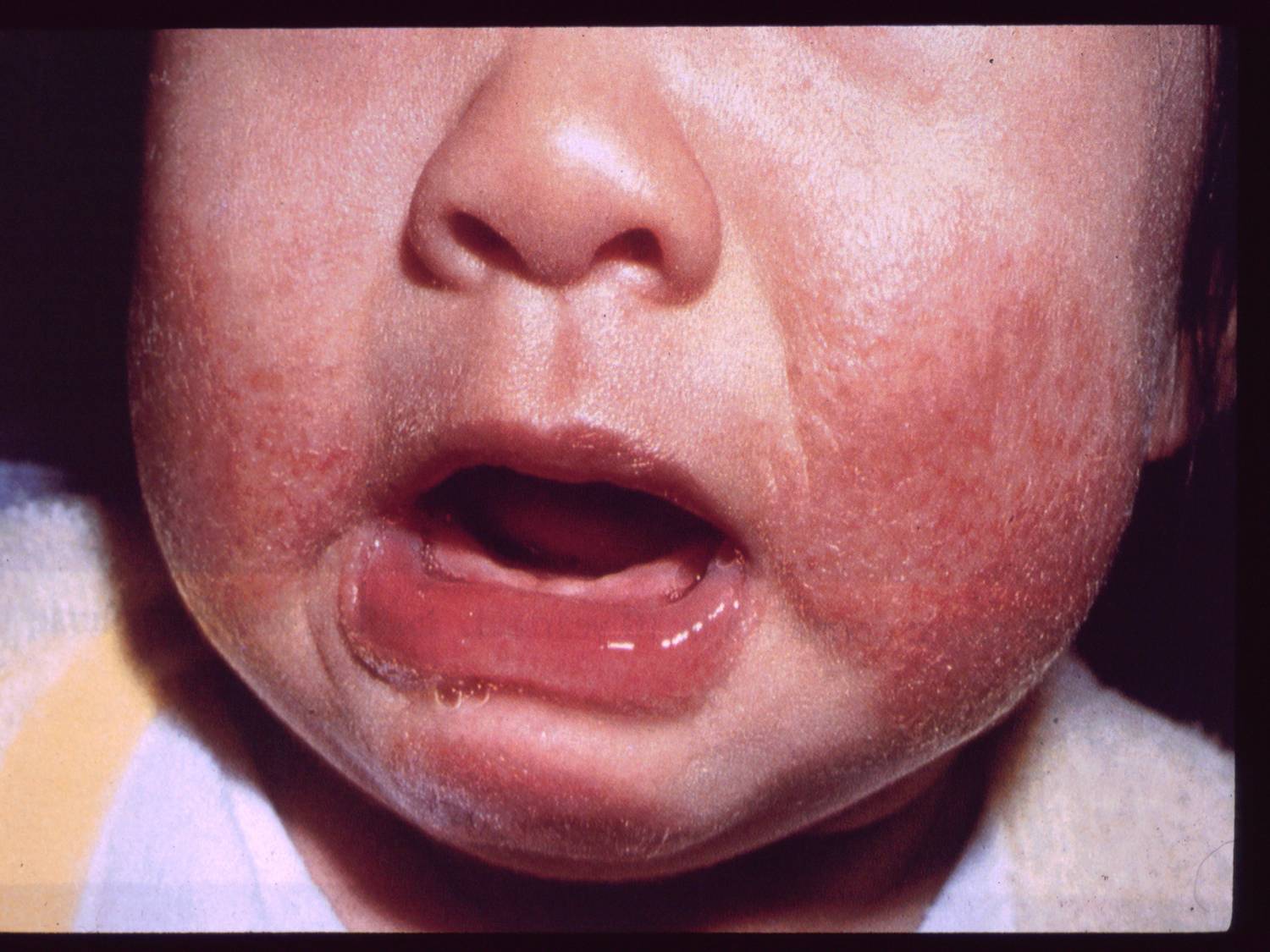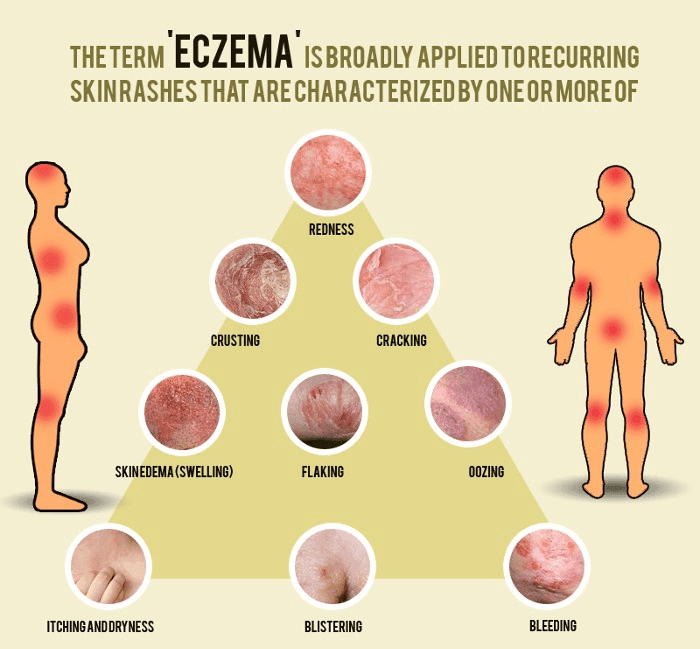Differences In Rash Appearance By Age
The appearance of atopic dermatitis may depend on your age. In fact, one of the biggest differences between childhood and adult eczema is how it looks on the skin:
- Infants tend to have rashes on the scalp and face, particularly on the cheeks, chin, scalp, and forehead. Skin usually looks weepy and red.
- Babies between 6 months and 12 months often develop eczema on their knees and elbows because of irritation from crawling.
- Toddlers also experience irritation around the knees and elbows but may develop a rash on their ankles, hands, and wrists. A rash around the eyes and mouth is also common in kids under 5. The rash is also more likely to appear scaly.
- Children over 5 typically have rashes behind the knees and in the folds of the elbows. At this age, some people have rashes only on their hands.
- In adults, rashes may appear in these areas but are more common on the hands and eyelids. People who have had lifelong eczema may have thick patches of skin that are darker or lighter than other areas.
Key Points About Atopic Dermatitis In Children
-
Atopic dermatitis is a long-term skin condition. It’s common in babies and children.
-
A child with allergies or family members with atopic dermatitis has a higher chance of having atopic dermatitis.
-
Itching, dryness, and redness are common symptoms.
-
The goals of treatment are to ease itching and inflammation of the skin, increase moisture, and prevent infection.
-
Staying away from triggers is important to manage the condition.
-
It usually gets better or goes away as a child gets older.
Is Cradle Cap Eczema
Seborrheic dermatitis, or cradle cap, is actually not eczema, though it can look like it. Cradle cap is excessive output of sebum from the sebaceous, or oil glands. Too much sebum or a change in sebum creates an oily coating, crusts, or scales on the scalp or face. Cradle cap can show up between 2 weeks and 12 months old.
Cradle cap is not usually itchy, which is a key difference between atopic dermatitis of the scalp and cradle cap.
Cradle cap forms on the top of the scalp and is not usually itchy.
Some of the microbes on skin are yeasts. Too much yeast can cause yeast infections, athlete’s foot, and dandruff in adults. In babies, yeast overgrowth is responsible for cradle cap.
Instead of avoiding baths and adding moisturizer to cradle cap, the best treatment is washing your baby’s hair once a day with a mild dandruff shampoo. You can also use petroleum jelly to loosen any scales, and then use a soft brush to gently remove excess skin.
You May Like: How Long Does Eczema Last
How To Treat Eczema
The treatment for eczema can vary based on the type of eczema you have and how severe it is.
For a typical case of atopic dermatitis, your doctor may suggest applying a moisturizer to the affected areas of skin several times per day. You may also benefit from applying a topical corticosteroid or taking an antihistamine if theyre experiencing a lot of itching.
Eczema On Neck Pictures:

Eczema on Neck is a skin condition that cause the skin to become red, inflamed, dry and itchy. The dry patches can be seen all over the body but most prominently on the neck, elbows and thighs. The dry skin causes itching and gets the condition worse. Avoid triggers and allergens to get rid of the condition. Immediately seek for a medical help and try changing your daily regime. Include foods that are beneficial for itch control and manage the skin condition by the daily regimes prescribed by your doctor.
Also ReadEczema & Dry Skin Relief Causes, Natural Treatments & Remedies
You May Like: How To Treat Itchy Nipple Eczema
Ways To Prevent Baby Eczema
Eczema itself cannot be prevented, but knowing and avoiding triggers can help prevent flare-ups of the condition.
Some ways to reduce triggers include:
- Keep your child out of cold, dry air.
- If they are 6 months or older, make sure your child gets an annual flu shot.
- Read labels on products to help your family avoid common irritants.
- Double-rinse your laundry to remove detergent residue.
Scalp Eczema Pictures :
Most common type of eczema is seborrheic dermatitis. Scalp eczema is a type of eczema that causes dry, inflamed, itchy, irritated and flaky skin. The skin condition can affect any age group ranging from infants to adults. When a babys scalp gets the same symptoms its often termed as cradle cap. The treatment methods may include natural, medicated remedies and self care daily regime to get rid of the condition. Its important to manage and control eczema as soon as possible to enjoy calm and stress free lives. Use medicated shampoo to treat seborrhoeic dermatitis of scalp also it can be noted that the shampoos that are made to treat dandruff can do wonders if you have mild eczema. Keep yourself hydrated to manage and control the symptoms of eczema.
Read More AboutNatural Remedies For Scalp Eczema
Read Also: Is Sauna Good For Eczema
When To Speak With A Doctor
It is advisable to speak with a doctor if symptoms become more severe or if it is difficult to manage the condition at home. If eczema is beginning to impact a childs everyday life, such as disrupting sleep or there are frequent infections from scratching their skin, a parent caregiver can consider contacting a doctor.
How Is Eczema Treated
There is no cure for eczema. But treatments can help with symptoms. The doctor will recommend different treatments based on how severe the symptoms are, the child’s age, and where the rash is. Some are “topical” and applied to the skin. Others are taken by mouth.
Topical moisturizers. Skin should be moisturized often . The best time to apply moisturizer is after a bath or shower, with the skin patted dry gently. Ointments and creams are best because they contain a lot of oil. Lotions have too much water to be helpful.
Topical corticosteroids, also called cortisone or steroid creams or ointments. These ease skin inflammation. It’s important not to use a topical steroid prescribed for someone else. These creams and ointments vary in strength, and using the wrong strength in sensitive areas can damage the skin, especially in infants.
Other topical anti-inflammatory medicines. These include medicines that change the way the skin’s immune system reacts.
Medicine taken by mouth. These can include antihistamines to help itchy kids sleep better at night, antibiotics if a rash gets infected by bacteria, and corticosteroid pills or other medicines that suppress the immune system.
Other types of treatment can include:
- wet wraps: damp cloths placed on irritated areas of skin
- bleach baths: bathing in very diluted bleach solution
Don’t Miss: Why Does Eczema Get Itchy At Night
Natural Remedies For Baby Eczema
If you need some extra help soothing babys skin, these natural eczema treatments may make things better.
- Wet a washcloth. Drape cool, wet washcloths or gauze over your babys irritated skin for five to ten minutes at a time or however long you can get your squirmy worm to cooperate.
- Try an oatmeal bath. Sprinkle a bit of uncooked oatmeal, colloidal oatmeal or even baking soda into the tub when you wash your baby. All can naturally relieve eczema and irritation.
- Combat dry air. Running a cool-mist humidifier in your baby’s bedroom can help keep her skin super-hydrated. Clean it frequently to prevent bacteria and mold buildup.
- Dress your little one in layers. Sweating can reboot the eczema cycle, and thats the last thing you want. Layers let you customize babys outfit for toasty temps.
- Ask your pediatrician about probiotics. Studies are underway to see whether probiotics may ease eczema when added to dry baby formula or served as a dietary supplement. Get your doctor to weigh in before giving it a go.
Should I Worry About Using The Topical Steroids Prescribed By My Healthcare Professional
No, you dont need to worry, as long as you follow your healthcare professionals specific instructions. Topical steroids are first-line treatments for babies with eczema. These creams have been used to treat eczema for more than 50 years, so there is a good understanding of how they work.
If you dont treat the eczema promptly and adequately, skin damage is far more likely to occur through scratching into the deeper layers of skin.
You May Like: What To Do For Itchy Eczema
Avoiding Triggers With Eczema
A GP will work with you to establish what might trigger the eczema flare-ups, although it may get better or worse for no obvious reason. Once you know your triggers, you can try to avoid them.
For example:
- if certain fabrics irritate your skin, avoid wearing these and stick to soft, fine-weave clothing or natural materials such as cotton
- if heat aggravates your eczema, keep the rooms in your home cool, especially the bedroom
- avoid using soaps or detergents that may affect your skin use soap substitutes instead
Although some people with eczema are allergic to house dust mites, trying to rid your home of them is not recommended as it can be difficult and theres no clear evidence that it helps.
Food Allergy And Eczema Flare

- Food allergies are a factor in 30% of young children with severe eczema. This factor is mainly seen in babies.
- The main allergic foods are cow’s milk and eggs.
- The main symptoms are increased skin redness and itching. Some parents report these symptoms start during or soon after the feeding.
- The eczema becomes easier to control if you avoid the allergic food.
Read Also: Baby Eczema On Legs Treatment
Is Eczema Different For Infants Or Toddlers Than It Is For Older Children
A painful, itchy rash on a babys face, torso or body may be eczema
Eczema looks and acts differently in infants and toddlers than it does in older children. The location and appearance of eczema changes as they grow, so its important to know what to look for during every stage of your infant or toddlers life.
What Causes Eczema To Wax To Flare
Different “triggers” can make eczema worse. For infants, these can be irritants such as wool, certain detergents or extreme temperatures, or other immune triggers, such as food allergies and asthma, and even pet dander.
Most kids with the condition have the hardest time in winter, when the air is cold and dry. A small percentage has a harder time in the summer, when it is hot and humid.
Recommended Reading: Natural Eczema Treatment For Adults
How Can You Prevent Baby Eczema
If your baby has contact dermatitis, you can try your best to prevent a flare-up by identifying and avoiding common triggers, which might include:
- Moisture . Dress your baby in lightweight cotton clothing. Gently pat drool away when you see it.
- Scratchy fabrics. In addition to clothes and rugs, even your babys stuffed animals can trigger eczema.
- Allergens. Think pet dander, pollen or dust.
- Harsh detergents and soaps. Consider using a sensitive detergent when washing babys clothes and crib sheets.
Seborrheic Dermatitis Aka Cradle Cap
Seborrheic dermatitis, known as cradle cap in infants, mainly affects the scalp. It can also affect other areas of your babys body that are high in oil glands, like the nose, around the eyes, and their backs. Seborrheic dermatitis is known as dandruff when it occurs in adults and older children. Signs that your child is affected by this eczema are yellow crust, red skin with white or yellow flakes, pink patches that join with the red skin, and swollen areas of skin. This type of eczema isnt typically painful for babies. The National Eczema Association recommends treating seborrheic dermatitis by applying a thin layer of moisturizing product on the affected area. This helps soften the scales and flakes before a bath to make removal safe and comfortable.
You May Like: Good Face Wash For Eczema
How Can I Manage Eczema
You can find a whole host of useful tips on our eczema Factsheet but here are 3 top tips to follow:
When To Seek Medical Advice
See a GP if you have symptoms of atopic eczema. They’ll usually be able to diagnose atopic eczema by looking at your skin and asking questions, such as:
- whether the rash is itchy and where it appears
- when the symptoms first began
- whether it comes and goes over time
- whether there’s a history of atopic eczema in your family
- whether you have any other conditions, such as allergies or asthma
- whether something in your diet or lifestyle may be contributing to your symptoms
Typically, to be diagnosed with atopic eczema you should have had an itchy skin condition in the last 12 months and 3 or more of the following:
- visibly irritated red skin in the creases of your skin such as the insides of your elbows or behind your knees at the time of examination by a health professional
- a history of skin irritation occurring in the same areas mentioned above
- generally dry skin in the last 12 months
- a history of asthma or hay fever children under 4 must have an immediate relative, such as a parent, brother or sister, who has 1 of these conditions
- the condition started before the age of 2
Recommended Reading: What Foods Help Reduce Eczema
Gravitational Eczema Varicose Eczema Stasis Eczema
Gravitational eczema , is seen on the legs, particularly around the ankles in those who have had long-standing varicose veins for many years. Not only does eczema appear, the skin can also darken and may eventually ulcerate if left untreated. Other symptoms include weeping and crusting and varicose leg ulcers .
Varicose eczema is common later in life and is more common in women than men. If you have poor circulation, varicose veins, are overweight or obese, or if you have previously had a blood clot, you have an increased risk of developing varicose eczema. Poor circulation and varicose veins can be caused by:
- weakened blood vessels caused by poor diet ,
- malnutrition,
- ageing which causes poor digestion of foods
- sedentary lifestyle, and
- being overweight or obese
Can Food Allergies Cause Eczema

Children are born with the tendency to have eczema, and many things can make their eczema worse. These are known as eczema triggers. Eczema in children can have various triggers, of which food can be one, especially in babies. However, foods are not the primary cause of eczema.
You may be asked to keep a food diary to try to determine whether a specific food makes your symptoms worse. Allergy tests are not usually needed, although theyre sometimes helpful in identifying whether a food allergy may be triggering symptoms.
Read Also: Best Treatment For Eczema On Arms
What Should I Do If My Babys Eczema Gets Worse
If your baby has wet, weepy skin and their eczema is not getting better with steroids, their skin may be infected and they may need antibiotics. If your babys eczema flare does not get better with the standard treatments recommended by the National Institute for Health and Care Excellence , your GP should refer them to a dermatology specialist. If they suspect an allergy, they should refer them to an allergist or joint dermatologyallergy clinic.
Which Is The Best Emollient For My Baby
Emollients treat dry skin by providing a surface film of oils. This increases water in the upper layer of the skin, restoring and providing a robust skin barrier, to prevent the entry of environmental agents or triggers.
Emollients soften the skin and reduce itch. If they are used regularly to maintain skin hydration, they can reduce the frequency of eczema flares. Leave-on emollients include lotions, creams,ointments and gels.
The emollient advised or prescribed for your baby should prevent dry skin and not cause irritation. You might need to try several products until you find the right one. Apply leave-on emollients regularly, throughout the day for example, at every nappy change and after bathing.
Use the product liberally . To apply the product, dot it all over the skin, and then smooth it in, using a gentle, downward, stroking motion rather than rubbing in.
Read Also: Best Eczema Doctor In The World
Foods That May Help With Eczema
Several foods can be beneficial for eczema and may help reduce symptoms such as itching and inflammation.
For example, fruits and vegetables are rich in antioxidants, which are compounds that can protect against oxidative stress, cell damage, and inflammation .
Although studies in humans are still limited, some research suggests that reducing oxidative stress could play a role in managing eczema .
Increasing your intake of probiotics through fermented foods or supplements may also be helpful.
According to one review of 13 studies, certain strains of probiotics were effective at reducing eczema severity in children. These strains included Lactobacillus fermentum and Lactobacillus salivarius .
However, more research is needed because other studies have found that probiotics do not have a significant effect on symptom severity or quality of life for those with eczema .
Summary
Including more foods rich in antioxidants and probiotics in your childs diet could be beneficial for eczema, but more research is needed.